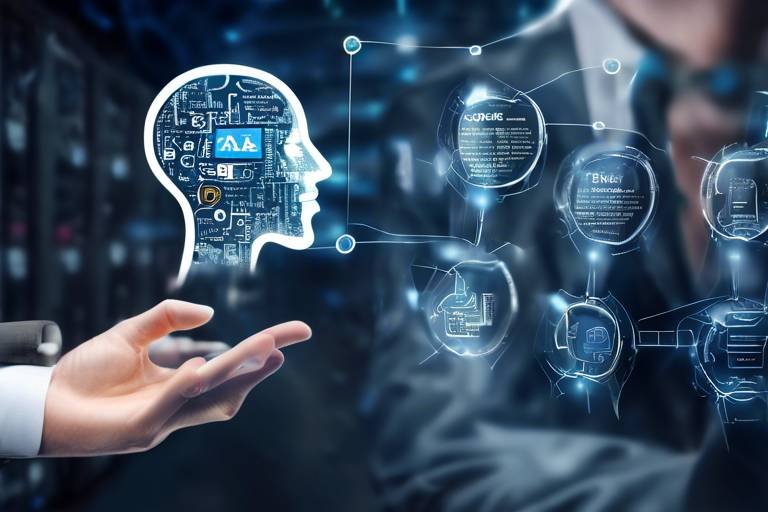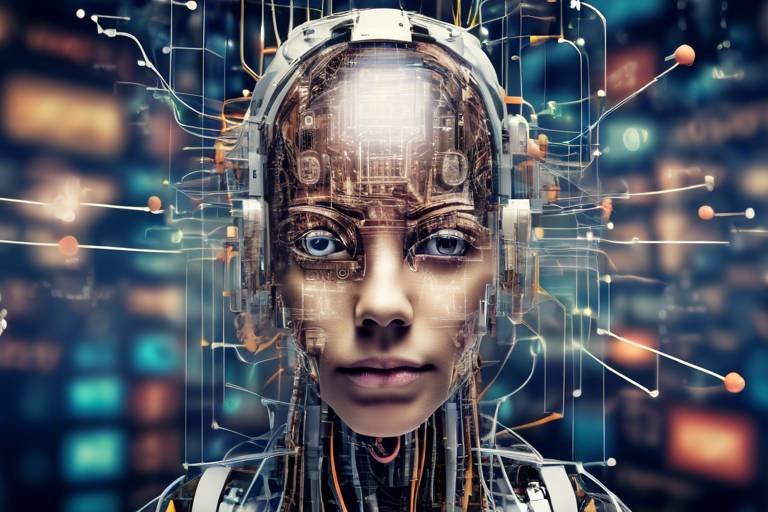AI and Its Role in Enhancing E-Learning
In today's fast-paced digital world, artificial intelligence (AI) is not just a buzzword; it’s a game-changer, especially in the realm of education. Imagine a classroom where each student receives a unique learning experience tailored specifically to their needs. This is the magic of AI in e-learning. It’s transforming traditional educational practices by introducing innovative technologies and methodologies that enhance personalization, boost engagement, and improve efficiency. But how does it all work? Let’s dive into the fascinating world of AI and explore its transformative role in enhancing e-learning experiences.
One of the most significant advantages of AI in e-learning is its ability to create personalized learning experiences. Gone are the days of a one-size-fits-all approach to education. With AI, learning paths can be tailored to meet the unique needs of each student. This means that whether you're a visual learner, an auditory learner, or someone who learns best through hands-on experiences, AI can adapt the content accordingly. This dynamic approach fosters a more engaging and effective educational experience for learners of all backgrounds.
Imagine having a personal tutor available 24/7, ready to assist you whenever you need help. That’s exactly what intelligent tutoring systems offer. Leveraging AI, these systems provide real-time feedback and support, simulating the experience of one-on-one tutoring. They can identify knowledge gaps and adjust the content in real-time, ensuring that students are always challenged but not overwhelmed. This tailored support significantly improves learning outcomes, making education more accessible and effective.
Another exciting feature of AI in e-learning is adaptive assessments. These assessments adjust their difficulty based on a student’s performance, providing a more accurate measure of understanding. For example, if a student excels in a particular area, the assessment can increase in complexity, challenging them further. Conversely, if a student struggles, the assessment can simplify, providing additional support. This dynamic approach not only helps educators identify areas needing improvement but also keeps students engaged and motivated to learn.
With AI, we can harness the power of real-time analytics. Educators can gain valuable insights into student performance and engagement, enabling timely interventions and support. Imagine being able to see which students are struggling and which concepts are difficult for the class as a whole, all at a glance. This data-driven approach enhances teaching strategies, allowing educators to tailor their methods and materials to better suit their students' needs.
Predictive analytics is another powerful tool in the AI arsenal. By analyzing patterns in data, institutions can identify at-risk students before they fall behind. This proactive approach allows for early intervention strategies, ensuring that learners receive the support they need to succeed. It’s like having a crystal ball that helps educators foresee challenges and tackle them head-on, ultimately improving student retention and success rates.
Let’s face it: learning can sometimes be a drag. But with AI facilitating gamification techniques, education becomes a lot more fun! By incorporating game elements into educational content, students are more likely to stay engaged and motivated. Think of it as turning a boring lecture into an exciting adventure game where each completed level represents a learning milestone. This approach not only increases motivation but also enhances retention of information, making learning a more enjoyable experience.
AI doesn’t just benefit students; it also helps educators by streamlining administrative tasks. Imagine a world where grading, scheduling, and communication are automated. This means teachers can spend less time on paperwork and more time interacting with students. The result? Improved operational efficiency in educational institutions. This shift allows educators to focus on what they do best: teaching and inspiring the next generation of learners.
Have you ever wished for instant support while studying late at night? AI-powered chatbots provide just that! These virtual assistants are available 24/7, ready to answer queries and guide students through resources. This constant availability enhances the learning experience, fostering student engagement and ensuring that help is always just a click away. It’s like having a study buddy who never sleeps!
Lastly, AI plays a crucial role in resource management within educational institutions. By optimizing resource allocation, AI ensures that materials and personnel are utilized effectively. This strategic management not only contributes to better educational outcomes but also helps institutions operate more sustainably. Think of it as having a smart assistant who knows exactly where to allocate resources for maximum impact.
- How does AI personalize learning? AI analyzes individual student data to create customized learning paths that cater to their specific needs and preferences.
- What are intelligent tutoring systems? These are AI-driven platforms that provide real-time feedback and support, simulating one-on-one tutoring experiences for students.
- Can AI help identify at-risk students? Yes, predictive analytics can analyze data patterns to identify students who may be struggling, allowing for timely interventions.
- What is gamification in learning? Gamification involves incorporating game-like elements into educational content to make learning more engaging and motivating.
- How do chatbots enhance student support? AI chatbots provide instant, round-the-clock assistance to students, answering questions and guiding them through learning resources.

Personalized Learning Experiences
In the ever-evolving world of education, have emerged as a game changer, thanks to the incredible capabilities of artificial intelligence. Imagine stepping into a classroom where every lesson is tailored just for you, where your unique learning style and pace are taken into account. Sounds like a dream, right? Well, with AI, this dream is becoming a reality. By analyzing individual student data, AI can create customized learning paths that not only enhance engagement but also boost the effectiveness of the learning process.
One of the most exciting aspects of personalized learning is its ability to cater to students from diverse backgrounds. Whether you're a visual learner who thrives on videos and infographics or an auditory learner who absorbs information through listening, AI-driven platforms can adjust content delivery to suit your preferences. This adaptability fosters a more inclusive educational environment, where every student has the opportunity to excel.
Furthermore, personalized learning experiences can significantly improve student motivation. When learners see that their educational journey is tailored to their needs, they are more likely to stay engaged and committed. This is akin to having a personal coach who understands your strengths and weaknesses, guiding you through challenges while celebrating your victories. The result? A more profound and meaningful learning experience that resonates with each student.
To illustrate the impact of personalized learning, consider the following table that showcases how AI can transform traditional educational practices:
| Traditional Learning | Personalized Learning with AI |
|---|---|
| One-size-fits-all curriculum | Customized learning paths based on individual needs |
| Standardized assessments | Dynamic assessments that adapt to student performance |
| Limited feedback | Real-time feedback and support from intelligent systems |
| Passive learning environments | Interactive platforms that encourage active participation |
Moreover, AI's ability to harness data analytics plays a crucial role in refining personalized learning experiences. By continuously monitoring student progress, AI systems can identify patterns and predict future performance, allowing educators to make informed decisions regarding instructional strategies. This proactive approach ensures that no student falls through the cracks, as timely interventions can be implemented to address learning gaps.
In conclusion, personalized learning experiences powered by AI not only enhance student engagement but also foster a more effective and inclusive educational environment. As we continue to embrace these innovative technologies, the future of education looks brighter than ever, paving the way for a generation of learners who are equipped to thrive in an ever-changing world.
- What is personalized learning?
Personalized learning refers to educational approaches that tailor learning experiences to meet the individual needs and preferences of each student. - How does AI contribute to personalized learning?
AI analyzes student data to create customized learning paths, adapt content delivery, and provide real-time feedback, making education more effective and engaging. - Can personalized learning benefit all students?
Yes, personalized learning can accommodate diverse learning styles and backgrounds, ensuring that every student has the opportunity to succeed. - What role does data analytics play in personalized learning?
Data analytics helps educators monitor student progress, identify patterns, and implement timely interventions to support learners effectively.

Intelligent Tutoring Systems
Imagine having a personal tutor available 24/7, ready to assist you whenever you hit a roadblock in your learning journey. Intelligent Tutoring Systems (ITS) are revolutionizing the educational landscape by providing students with tailored support that mimics one-on-one tutoring. These systems leverage the power of artificial intelligence to analyze a student's performance in real-time, identifying knowledge gaps and adjusting the content accordingly. This means that no learner is left behind, as the system adapts to their unique needs and pace.
One of the most exciting aspects of ITS is their ability to offer immediate feedback. Traditional classroom settings can often leave students waiting for days to receive grades or comments on their assignments. With ITS, feedback is instantaneous, allowing students to understand their mistakes and learn from them right away. This real-time interaction not only enhances learning outcomes but also keeps students motivated and engaged. Think of it like having a GPS for your education—if you take a wrong turn, the system recalibrates and guides you back on track.
Furthermore, ITS can cater to a variety of learning styles. Some students excel with visual aids, while others may prefer auditory explanations. By utilizing machine learning algorithms, these systems can determine the most effective way to present information to each student. For example, if a student struggles with a mathematical concept, the ITS may provide additional visual resources or interactive simulations to reinforce understanding. This personalized approach fosters a more inclusive learning environment where every student can thrive.
To illustrate the effectiveness of Intelligent Tutoring Systems, consider the following table that summarizes key features and benefits:
| Feature | Benefit |
|---|---|
| Real-Time Feedback | Immediate correction of misunderstandings, enhancing learning efficiency. |
| Personalized Learning Paths | Tailored content that adapts to individual student needs and learning speeds. |
| Engagement through Interactivity | Increased motivation and retention through interactive learning experiences. |
| Data-Driven Insights | Educators receive valuable insights into student performance for targeted interventions. |
In conclusion, Intelligent Tutoring Systems are not just a passing trend; they are a vital component of the future of education. By harnessing the capabilities of AI, these systems provide a personalized, engaging, and efficient learning experience that meets the diverse needs of students. As educational institutions continue to adopt these technologies, the possibilities for enhancing learning outcomes are truly limitless.
- What is an Intelligent Tutoring System?
An ITS is an AI-based platform that provides personalized tutoring and feedback to students, adapting to their individual learning needs. - How does an ITS improve learning outcomes?
By offering immediate feedback and personalized learning paths, ITS helps students grasp concepts more effectively and stay engaged. - Can ITS cater to different learning styles?
Yes, ITS can adapt content delivery based on the preferred learning style of the student, whether visual, auditory, or kinesthetic. - Are Intelligent Tutoring Systems effective in all subjects?
While ITS has shown success in various subjects, their effectiveness can vary based on the design and implementation of the system.

Adaptive Assessments
This article explores how artificial intelligence is transforming the e-learning landscape, improving personalization, engagement, and efficiency in educational practices through innovative technologies and methodologies.
AI enables the creation of tailored learning paths that adapt to individual student needs, enhancing engagement and effectiveness. This approach fosters a more personalized educational experience for learners of all backgrounds.
Intelligent tutoring systems leverage AI to provide real-time feedback and support, simulating one-on-one tutoring. These systems can identify knowledge gaps and adjust content accordingly, improving learning outcomes.
Adaptive assessments are a game-changer in the world of e-learning. Imagine taking a test that knows your strengths and weaknesses better than you do! With the power of AI, these assessments adjust their difficulty based on your performance in real-time. This means that if you breeze through the easy questions, the system will present you with more challenging ones, pushing you to think critically and deepen your understanding.
Conversely, if you struggle with certain concepts, the assessment will adapt by offering simpler questions, allowing you to build your confidence and knowledge gradually. This dynamic approach not only provides a more accurate measure of your understanding but also creates a more engaging and less stressful testing environment. After all, who wants to feel overwhelmed during a test?
Here's how adaptive assessments work:
- Initial Assessment: The process begins with a baseline test that gauges your current knowledge level.
- Real-Time Adjustments: As you answer questions, the system analyzes your responses and modifies the difficulty accordingly.
- Feedback Mechanism: You receive immediate feedback on your answers, helping you understand where you went wrong and how to improve.
- Comprehensive Reporting: Educators receive detailed reports on student performance, highlighting areas that need attention.
This adaptability not only enhances learning outcomes but also empowers educators to tailor their teaching strategies based on solid data. They can pinpoint the areas where students struggle the most and adjust their lessons to address these gaps effectively. In essence, adaptive assessments turn the traditional testing model on its head, making it a more personalized and insightful experience for both students and teachers.
Real-time analytics powered by AI can provide educators with insights into student performance and engagement, enabling timely interventions and support. This data-driven approach enhances teaching strategies.
Predictive analytics can help institutions identify at-risk students by analyzing patterns in data. Early intervention strategies can then be implemented to support these learners effectively.
AI facilitates gamification techniques that make learning more engaging and interactive. By incorporating game elements, educational content becomes more appealing, promoting motivation and retention.
AI streamlines administrative tasks, allowing educators to focus more on teaching. Automation of grading, scheduling, and communication improves overall operational efficiency in educational institutions.
AI-powered chatbots provide instant support to students, answering queries and guiding them through resources. This 24/7 availability enhances the learning experience and fosters student engagement.
AI aids in optimizing resource allocation within educational institutions, ensuring that materials and personnel are utilized effectively. This strategic management contributes to better educational outcomes.
1. What are adaptive assessments?
Adaptive assessments are testing methods that adjust their difficulty based on a student's performance, providing a personalized evaluation of their knowledge and skills.
2. How do adaptive assessments improve learning?
By tailoring questions to the individual learner, adaptive assessments help identify knowledge gaps and allow students to progress at their own pace, ultimately enhancing their learning experience.
3. Can adaptive assessments benefit educators?
Absolutely! Educators receive valuable insights into student performance, enabling them to adjust their teaching strategies and focus on areas that require more attention.

Real-Time Analytics
In the fast-paced world of e-learning, have emerged as a game-changer, revolutionizing how educators track and enhance student performance. Imagine being able to see how your students are engaging with the material at any given moment. This is not just a dream; it's a reality made possible by the power of artificial intelligence. With real-time data, educators can gain insights into student behavior, engagement levels, and even content comprehension.
By leveraging AI-driven analytics, teachers can monitor a variety of metrics, such as:
- Time Spent on Tasks: Understanding how long students are spending on assignments can help identify those who may be struggling.
- Interaction Rates: Tracking how often students interact with course materials provides insights into their engagement levels.
- Assessment Performance: Analyzing quiz and test scores in real-time allows educators to adjust their teaching strategies on the fly.
These insights are invaluable, as they enable educators to intervene promptly when a student is falling behind or struggling with specific concepts. For instance, if a student consistently scores low on quizzes about a particular topic, the educator can quickly provide additional resources or one-on-one support to address the knowledge gap.
Moreover, real-time analytics can facilitate a more dynamic teaching environment. Instead of waiting for the end of a term to review overall performance, teachers can adapt their lesson plans based on live feedback, ensuring that the learning experience is always relevant and effective. This adaptability is akin to steering a ship; rather than waiting for the storm to pass, educators can adjust their sails to navigate through challenges as they arise.
To illustrate the impact of real-time analytics in e-learning, consider the following table that summarizes key benefits:
| Benefit | Description |
|---|---|
| Immediate Feedback | Students receive instant feedback on their performance, allowing them to adjust their study habits accordingly. |
| Targeted Interventions | Educators can identify at-risk students and provide necessary support before issues escalate. |
| Data-Driven Decisions | Teaching strategies can be refined based on real-time data, enhancing overall educational outcomes. |
In conclusion, the integration of real-time analytics into e-learning platforms not only empowers educators but also enriches the learning experience for students. By embracing these advanced technologies, educational institutions can foster a more responsive and effective learning environment, ultimately paving the way for greater academic success.
- What is real-time analytics in e-learning?
Real-time analytics refers to the immediate collection and analysis of data regarding student performance and engagement, allowing educators to make timely decisions. - How can real-time analytics improve student outcomes?
By providing instant feedback and insights, educators can identify struggling students and tailor their teaching strategies to meet individual needs. - What tools are commonly used for real-time analytics?
Many e-learning platforms incorporate built-in analytics tools, while others may use third-party software that integrates seamlessly with existing systems.

Predictive Analytics for Student Success
In the ever-evolving landscape of education, predictive analytics emerges as a game-changer, offering insights that were previously unimaginable. Picture this: a system that can analyze a myriad of data points from student interactions, academic performance, and engagement levels to forecast which students might be at risk of falling behind. This is not just a pipe dream; it's a reality thanks to the power of artificial intelligence.
By employing sophisticated algorithms, educational institutions can identify patterns that indicate potential challenges faced by students. For instance, if a student consistently struggles with specific subjects or fails to submit assignments on time, predictive analytics can flag these behaviors early on. This early detection is crucial because it allows educators to implement intervention strategies tailored to the individual needs of at-risk students before they spiral into deeper academic trouble.
One of the most compelling aspects of predictive analytics is its ability to create a comprehensive profile of each student. This profile can include:
- Academic history
- Engagement metrics (like participation in discussions or attendance)
- Behavioral patterns (such as time spent on assignments)
- Social interactions and peer performance
With this wealth of information, educators can make informed decisions that enhance student success rates. For example, if a pattern shows that students who engage in study groups perform better, schools can encourage collaborative learning environments. Moreover, predictive analytics can also assist in curriculum development by highlighting which teaching methods yield the best results for different types of learners.
Additionally, the implementation of predictive analytics can lead to significant improvements in resource allocation. By understanding which students need more support, schools can direct their resources—be it tutoring staff, online resources, or mental health services—where they are most needed. This strategic approach not only benefits the students but also enhances the overall efficiency of educational institutions.
However, it's essential to approach predictive analytics with a sense of responsibility. Data privacy and ethical considerations must be at the forefront of any initiative. Institutions need to ensure that they handle student data with the utmost care, implementing robust security measures to protect sensitive information. Transparency in how data is collected and used will also foster trust among students and parents.
In summary, predictive analytics is revolutionizing the educational landscape by providing actionable insights that can lead to improved student outcomes. As more institutions adopt these technologies, the potential for fostering a supportive and effective learning environment grows exponentially. With the right tools and strategies in place, we can ensure that every student has the opportunity to succeed.
- What is predictive analytics in education?
Predictive analytics in education refers to the use of data analysis techniques to identify patterns and predict student outcomes, helping educators intervene early and improve student success. - How does predictive analytics help at-risk students?
By analyzing data on student performance and engagement, predictive analytics can identify students who may be struggling, allowing for timely interventions tailored to their needs. - Are there privacy concerns with using predictive analytics?
Yes, it is crucial to handle student data responsibly, ensuring privacy and security while being transparent about how data is collected and used.

Gamification in Learning
In today's digital age, gamification has emerged as a powerful tool in the realm of e-learning, transforming mundane educational experiences into engaging adventures. Imagine walking into a classroom where learning feels less like a chore and more like an exciting quest. That's the magic of gamification! By infusing game-like elements into educational content, educators can significantly increase student motivation and retention. Think about it: when was the last time you were genuinely excited to complete a worksheet? Now, picture that same worksheet transformed into a challenging game where you earn points for every correct answer. Sounds fun, right?
The essence of gamification lies in its ability to tap into the innate human desire for achievement and competition. By introducing elements such as points, badges, and leaderboards, learners are encouraged to push their limits and strive for excellence. This approach not only makes learning more enjoyable but also fosters a sense of community among students as they collaborate and compete with one another. For instance, a classroom could implement a leaderboard showcasing the top performers in a math game, motivating others to improve their skills to climb the ranks.
Moreover, gamification provides immediate feedback, which is crucial for effective learning. When students engage with interactive quizzes or challenges, they receive instant results that help them understand their strengths and weaknesses. This real-time feedback loop encourages a growth mindset, where students are more likely to embrace challenges and learn from their mistakes. As they progress through levels or unlock new achievements, they gain a sense of accomplishment that fuels their desire to learn more.
To illustrate the impact of gamification, consider the following table that highlights various game elements and their educational benefits:
| Game Element | Educational Benefit |
|---|---|
| Points | Encourages participation and provides a sense of achievement. |
| Badges | Recognizes accomplishments, motivating students to reach specific goals. |
| Leaderboards | Fosters healthy competition and community among learners. |
| Challenges | Encourages problem-solving and critical thinking skills. |
However, it's essential to implement gamification thoughtfully. Overemphasis on competition can lead to anxiety among students who may feel pressured to perform. Therefore, a balanced approach that combines collaboration with competition can create a more inclusive learning environment. Additionally, educators should ensure that the game elements align with the learning objectives to maintain educational integrity.
In conclusion, gamification is not just a passing trend; it is a revolutionary approach that reinvigorates the learning process. By making education more interactive and enjoyable, gamification helps students develop a love for learning that can last a lifetime. So, the next time you find yourself in a classroom, remember that learning can be an adventure, and with the right tools, every student can become a hero in their educational journey.
Q: What is gamification in learning?
A: Gamification in learning refers to the integration of game-like elements such as points, badges, and challenges into educational activities to enhance student engagement and motivation.
Q: How does gamification improve student performance?
A: By providing immediate feedback, fostering a sense of achievement, and promoting healthy competition, gamification encourages students to actively participate and strive for excellence.
Q: Are there any downsides to gamification?
A: While gamification can be highly beneficial, an overemphasis on competition may lead to anxiety for some students. It's essential to balance competitive elements with collaborative activities to create an inclusive environment.
Q: Can gamification be applied in all subjects?
A: Yes! Gamification can be adapted to various subjects and learning contexts, making it a versatile tool for educators across disciplines.

Enhanced Administrative Efficiency
In the bustling world of education, administrative tasks can often feel like a never-ending maze. Enter artificial intelligence, the game-changer that is revolutionizing how educational institutions manage their operations. By automating routine tasks, AI frees up valuable time for educators, allowing them to focus on what they do best: teaching and inspiring students. Imagine a world where grading, scheduling, and communication are handled seamlessly, almost like magic. This is not just a dream; it’s a reality that AI is bringing to life.
One of the most significant advantages of AI in administration is its ability to streamline processes. For instance, consider the grading system. Traditionally, grading can be a labor-intensive process that consumes hours of an educator's time. With AI, assessments can be graded automatically and efficiently, providing immediate feedback to students. This not only saves time but also allows educators to dedicate more attention to personalized instruction. In fact, studies have shown that institutions utilizing AI for grading can reduce the time spent on administrative tasks by up to 40%.
Furthermore, AI enhances communication within educational institutions. AI-powered systems can manage emails, schedule meetings, and even send reminders to students about upcoming deadlines or events. This level of automation ensures that everyone stays informed and engaged, reducing the chances of miscommunication. For example, a chatbot can handle frequently asked questions from students, providing instant responses and freeing up staff to tackle more complex inquiries.
| Task | Traditional Method | AI-Enhanced Method |
|---|---|---|
| Grading | Manual grading takes hours | Instant grading with AI tools |
| Scheduling | Manual scheduling conflicts | Automated scheduling with alerts |
| Communication | Emails and calls | AI chatbots for instant support |
Resource management is another area where AI shines. By analyzing data on resource usage, AI can help institutions optimize their materials and personnel allocation. This means that textbooks, technology, and even teaching staff can be deployed more effectively, ensuring that resources are available where they are needed most. For instance, if a particular course is seeing an influx of students, AI can recommend additional resources or staff to support that demand, enhancing the overall learning experience.
In summary, the integration of AI into administrative functions not only boosts efficiency but also transforms the educational landscape. By automating mundane tasks, enhancing communication, and optimizing resource management, AI allows educators to reclaim their time and focus on fostering a rich learning environment. It’s a win-win situation that benefits both educators and students alike. As we look to the future, the role of AI in education will only continue to grow, paving the way for more innovative practices and improved outcomes.
- What are the main benefits of using AI in education? AI enhances efficiency, personalization, and engagement in learning, allowing educators to focus on teaching.
- How does AI improve administrative tasks? AI automates routine tasks such as grading and scheduling, freeing up time for educators.
- Can AI help identify at-risk students? Yes, AI uses predictive analytics to identify students who may need additional support.
- What role do chatbots play in education? Chatbots provide instant support to students, answering queries and guiding them through resources.

Chatbots for Student Support
In the fast-paced world of education, chatbots have emerged as a revolutionary tool for enhancing student support. Imagine having a helpful assistant available 24/7, ready to answer questions, provide guidance, and assist with learning resources at any hour of the day or night. This is exactly what chatbots bring to the table. By leveraging artificial intelligence, these digital companions can engage with students in real-time, making the learning experience not only more accessible but also significantly more interactive.
One of the most significant advantages of chatbots is their ability to handle a multitude of inquiries simultaneously. Whether a student is confused about assignment deadlines, seeking clarification on course materials, or needing help navigating the online learning platform, chatbots are equipped to respond instantly. This immediacy alleviates stress and allows students to focus more on their studies rather than getting bogged down by administrative hurdles.
Furthermore, chatbots can offer personalized support based on individual student profiles. For instance, if a student has previously struggled with a particular subject, the chatbot can provide tailored resources, such as study guides, video tutorials, or practice quizzes. This level of customization fosters a more engaging learning environment, ensuring that students feel supported in their academic journey.
To illustrate the impact of chatbots in educational settings, consider the following table that highlights their key functionalities:
| Functionality | Description |
|---|---|
| 24/7 Availability | Students can access support anytime, reducing wait times for help. |
| Instant Responses | Chatbots provide immediate answers, enhancing student satisfaction. |
| Personalized Recommendations | Tailored content and resources based on individual student needs. |
| Data Collection | Chatbots can gather data on common student issues, helping institutions improve. |
Moreover, chatbots can significantly reduce the administrative burden on educators. By automating routine inquiries and providing consistent information, teachers can devote more time to what they do best: teaching. This shift not only improves efficiency but also enhances the overall educational experience for both students and faculty.
In conclusion, the integration of chatbots into the educational landscape is a game-changer. They not only provide essential support to students but also empower educators by streamlining processes. As technology continues to advance, the role of chatbots will undoubtedly expand, further enriching the e-learning environment.
- What are chatbots? Chatbots are AI-powered programs designed to simulate conversation with users, providing instant support and information.
- How do chatbots benefit students? They offer 24/7 assistance, personalized learning resources, and instant responses to queries, enhancing the overall learning experience.
- Can chatbots replace teachers? No, chatbots are designed to assist and support teachers, not replace them. They handle routine inquiries, allowing educators to focus on teaching.
- Are chatbots effective in education? Yes, studies show that chatbots can improve student engagement and satisfaction by providing timely support and resources.

Resource Management
In the ever-evolving landscape of education, has become a critical aspect of ensuring that institutions operate efficiently and effectively. With the integration of artificial intelligence, educational organizations can optimize the way they allocate resources such as materials, personnel, and technology. Imagine trying to run a school like a well-oiled machine; each part needs to work seamlessly together. AI acts as the grease in this machine, ensuring that everything runs smoothly.
One of the key benefits of AI in resource management is its ability to analyze vast amounts of data quickly. This capability allows institutions to make informed decisions based on real-time insights. For instance, AI can track student engagement levels and academic performance, enabling schools to allocate teaching resources where they are most needed. If one class is struggling with a particular subject, AI can recommend additional support, such as hiring a tutor or providing supplementary materials.
Furthermore, AI-driven systems can help in forecasting future resource needs. By analyzing trends in enrollment, course popularity, and student performance, educational institutions can anticipate the demand for teachers, classrooms, and learning materials. This proactive approach not only saves money but also enhances the overall educational experience. Imagine a school that knows exactly how many textbooks to order or how many teachers to hire before the school year begins—this is the power of AI in action.
Additionally, AI can streamline the management of physical resources. For example, smart scheduling systems can optimize classroom usage, reducing downtime and ensuring that facilities are used to their full potential. This is akin to a conductor leading an orchestra, ensuring that every instrument plays at just the right moment. By maximizing the use of space and resources, schools can create a more vibrant learning environment.
To illustrate the impact of AI on resource management, consider the following table that highlights key areas where AI can make a difference:
| Area of Resource Management | AI Application | Benefits |
|---|---|---|
| Personnel Allocation | Data-driven staffing recommendations | Improved student-teacher ratios |
| Material Distribution | Predictive analytics for textbook needs | Cost savings and reduced waste |
| Facility Management | Smart scheduling systems | Maximized use of classrooms and resources |
In conclusion, AI is not just a buzzword in the world of education; it is a game-changer for resource management. By harnessing the power of AI, educational institutions can ensure that they are not only meeting the needs of their students but also operating in a sustainable and efficient manner. The future of education is bright, and with AI leading the charge, we can expect to see significant improvements in how resources are managed, ultimately enhancing the learning experience for everyone involved.
- How does AI improve resource management in education?
AI analyzes data to optimize the allocation of materials, personnel, and technology, ensuring efficient operations. - Can AI predict future resource needs?
Yes, AI can forecast demand based on trends in enrollment and performance, helping institutions plan accordingly. - What are the benefits of using AI for scheduling?
AI-driven scheduling systems maximize the use of classrooms and resources, reducing downtime and improving efficiency.
Frequently Asked Questions
- What is AI's role in personalized learning?
AI plays a significant role in creating personalized learning experiences by analyzing individual student data to tailor educational content. This means that each student can receive a customized learning path that suits their unique strengths and weaknesses, making the learning process more engaging and effective.
- How do intelligent tutoring systems work?
Intelligent tutoring systems utilize AI algorithms to provide real-time feedback and support to students. These systems can identify gaps in knowledge and adjust the content accordingly, simulating a one-on-one tutoring experience that can greatly enhance learning outcomes.
- What are adaptive assessments?
Adaptive assessments are AI-driven evaluations that change their difficulty based on a student's performance during the test. This dynamic approach allows educators to gain a more accurate understanding of a student's knowledge and skills, helping to pinpoint areas that require further improvement.
- How can AI improve administrative efficiency in education?
AI enhances administrative efficiency by automating routine tasks such as grading, scheduling, and communication. This automation allows educators to dedicate more time to teaching and engaging with students, ultimately improving the overall educational experience.
- What benefits do chatbots provide for students?
AI-powered chatbots offer 24/7 support to students by answering questions and guiding them through resources. This instant access to information not only enhances the learning experience but also encourages greater student engagement by providing help whenever it's needed.
- How does predictive analytics contribute to student success?
Predictive analytics helps educational institutions identify at-risk students by analyzing data patterns related to performance and engagement. By recognizing these trends early, schools can implement targeted intervention strategies to support students before they fall behind.
- What role does gamification play in e-learning?
Gamification incorporates game-like elements into educational content, making learning more interactive and enjoyable. By adding challenges, rewards, and competition, AI helps to boost student motivation and retention, transforming traditional learning into a more engaging experience.
- How does AI optimize resource management in educational institutions?
AI optimizes resource management by analyzing data to ensure that materials and personnel are allocated effectively. This strategic approach helps institutions maximize their resources, leading to improved educational outcomes and a better overall learning environment.



















